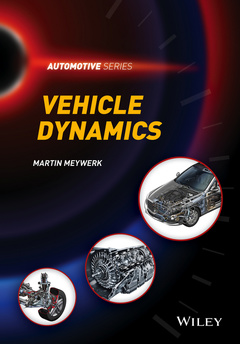Vehicle Dynamics Automotive Series
Auteur : Meywerk Martin

- Comprehensively covers the fundamentals of vehicle dynamics with application to automotive mechatronics
- Presents a number of different design, analysis and implementation considerations related to automobiles, including power requirements, converters, performance, fuel consumption and vehicle dynamic models
- Covers the dynamics, modeling and control of not only the entire vehicle system, but also of key elements of the vehicle such as transmissions, and hybrid systems integration
- Includes exercise problems and MATLAB® codes
- Accompanied by a website hosting animations
Foreword xi
Series Preface xiii
Preface xv
List of Abbreviations and Symbols xvii
1 Introduction 1
1.1 Introductory Remarks 3
1.2 Motion of the Vehicle 4
1.3 Questions and Exercises 8
2 The Wheel 11
2.1 Equations of Motion of the Wheel 11
2.2 Wheel Resistances 14
2.2.1 Rolling Resistance 14
2.2.2 Aquaplaning 18
2.2.3 Bearing Resistance 19
2.2.4 Toe-In/Toe-Out Resistance 19
2.3 Tyre Longitudinal Force Coefficient, Slip 20
2.4 Questions and Exercises 24
3 Driving Resistances, Power Requirement 27
3.1 Aerodynamic Drag 27
3.2 Gradient Resistance 29
3.3 Acceleration Resistance 29
3.4 Equation of Motion for the Entire Vehicle 32
3.5 Performance 34
3.6 Questions and Exercises 39
4 Converters 43
4.1 Clutch, Rotational Speed Converter 45
4.2 Transmission, Torque Converter 48
4.3 Questions and Exercises 54
5 Driving Performance Diagrams, Fuel Consumption 57
5.1 Maximum Speed without Gradient 60
5.2 Gradeability 61
5.3 Acceleration Capability 61
5.4 Fuel Consumption 63
5.5 Fuel Consumption Test Procedures 68
5.6 Questions and Exercises 70
6 Driving Limits 73
6.1 Equations of Motion 74
6.2 Braking Process 79
6.3 Braking Rate 84
6.4 Questions and Exercises 91
7 Hybrid Powertrains 93
7.1 Principal Functionalities 93
7.2 Topologies of Hybrid Powertrains 99
7.3 Regenerative Braking and Charging 101
7.4 Questions and Exercises 106
8 Adaptive Cruise Control 107
8.1 Components and Control Algorithm 107
8.2 Measurement of Distances and Relative Velocities 112
8.3 Approach Ability 117
8.4 Questions and Exercises 118
9 Ride Dynamics 121
9.1 Vibration Caused by Uneven Roads 124
9.1.1 Damped Harmonic Oscillator 124
9.1.2 Assessment Criteria 128
9.1.3 Stochastic Irregularities 130
9.1.4 Conflict between Safety and Comfort 132
9.2 Oscillations of Powertrains 144
9.2.1 Torsional Oscillators 144
9.2.2 Centrifugal Pendulum Vibration Absorbers 147
9.3 Examples 151
9.4 Questions and Exercises 152
10 Vehicle Substitute Models 155
10.1 Two-mass Substitute System 155
10.2 Two-axle Vehicle, Single-track Excitation 158
10.3 Non-linear Characteristic Curves 165
10.4 Questions and Exercises 167
11 Single-track Model, Tyre Slip Angle, Steering 169
11.1 Equations of Motion of the Single-track Model 169
11.2 Slip Angle 177
11.3 Steering 181
11.4 Linearized Equations of Motion of the Single-track Model 185
11.5 Relationship between Longitudinal Forces and Lateral Forces in the Contact Patch 188
11.6 Effect of Differentials when Cornering 189
11.7 Questions and Exercises 191
12 Circular Driving at a Constant Speed 193
12.1 Equations 193
12.2 Solution of the Equations 195
12.3 Geometric Aspects 197
12.4 Oversteering and Understeering 201
12.5 Questions and Exercises 205
13 Dynamic Behaviour 207
13.1 Stability of Steady-state Driving Conditions 207
13.2 Steering Behaviour 210
13.3 Crosswind Behaviour 213
13.4 Questions and Exercises 216
14 Influence of Wheel Load Transfer 217
14.1 Wheel Load Transfer without Considering Vehicle Roll 217
14.2 Wheel Load Transfer Considering Vehicle Roll 221
14.3 Questions and Exercises 228
15 Toe-in/Toe-out, Camber and Self-steering Coefficient 229
15.1 Toe-in/Toe-out, Camber 229
15.2 Questions and Exercises 233
16 Suspension Systems 235
16.1 Questions and Exercises 245
17 Torque and Speed Converters 247
17.1 Speed Converters, Clutches 247
17.2 Transmission 252
17.3 Questions and Exercises 258
18 Shock Absorbers, Springs and Brakes 259
18.1 Shock Absorbers 259
18.2 Ideal Active Suspension and Skyhook Damping 264
18.2.1 Ideal Active Suspension 264
18.2.2 Skyhook Dampers 267
18.3 Suspension Springs 269
18.4 Brake Systems 277
18.5 Questions and Exercises 281
19 Active Longitudinal and Lateral Systems 283
19.1 Main Components of ABS 283
19.2 ABS Operations 287
19.3 Build-up Delay of Yaw Moment 290
19.4 Traction Control System 293
19.5 Lateral Stability Systems 294
19.6 Hydraulic Units for ABS and ESP 296
19.7 Active Steering System 297
19.8 Questions and Exercises 298
20 Multi-body Systems 301
20.1 Kinematics of Rigid Bodies 302
20.2 Kinetic Energy of a Rigid Body 305
20.3 Components of Multi-body Systems 309
20.4 Orientation of Rigid Bodies 312
20.5 Derivation and Solution of the Equations 315
20.5.1 Derivation of the Equations 315
20.5.2 Solution of Equations 316
20.6 Applications of MBS 317
20.7 Questions and Exercises 322
Glossary 323
References 329
Index 331
Previously he has worked on research projects with Volkswagen, BMW, Daimler, Bast and other companies. He is the course instructor for a Massive Online Open Course (MOOC) in vehicle dynamics.
Date de parution : 06-2015
Ouvrage de 360 p.
17.6x25.2 cm



